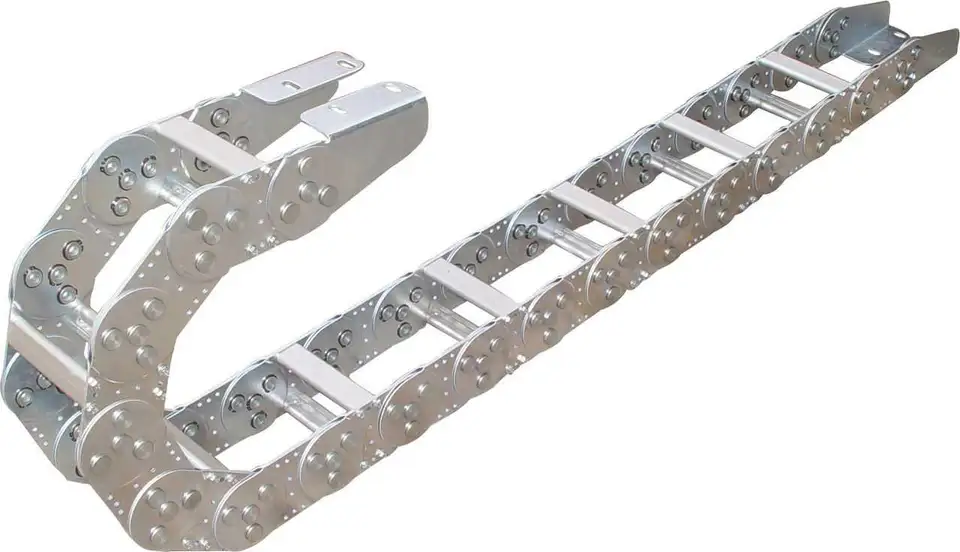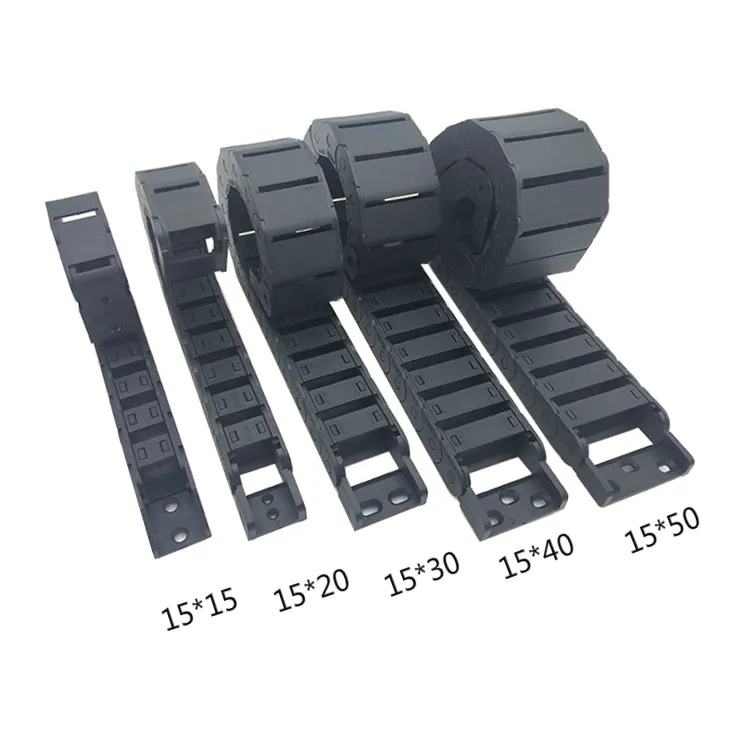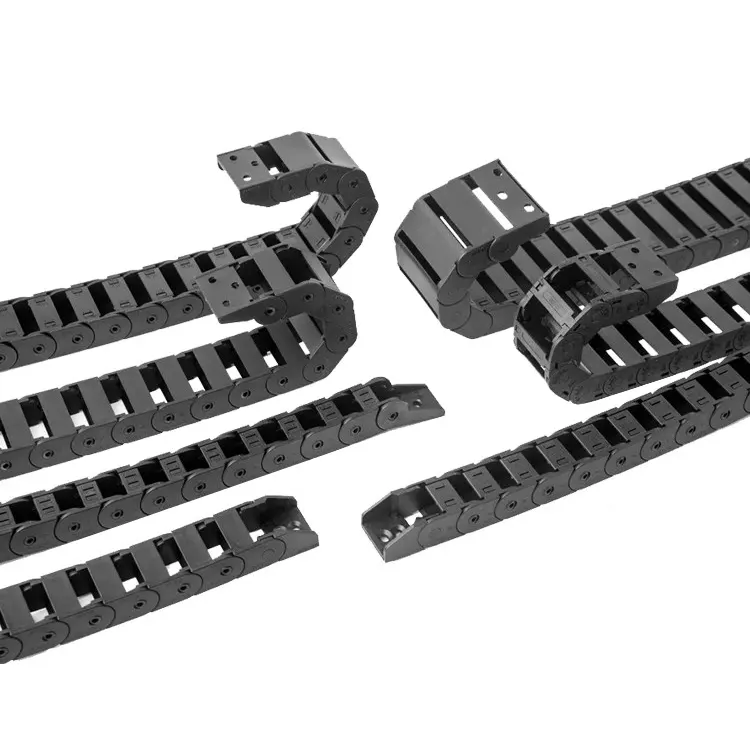Product Description
Usage characteristics of steel towing chain:
It is suitable for reciprocating occasions, and can play a role in traction and protection of built-in cables, oil pipes, gas pipes, water pipes, etc. Each section of the steel tow chain can be opened, which is convenient for installation and maintenance. Low movement noise, high speed movement. Steel drag chain has been widely used in CNC machine tools, electronic equipment, stone machinery, glass machinery, door and window machinery, injection molding machine, manipulator, lifting and transportation equipment, automated warehouse, etc.
Warm tip:
The steel drag chain can carry a large number of cables and oil pipes with heavy weight, and its free suspension length is large. The support plate can be made according to customers’ needs, and it is suitable for all mobile machines, etc. Its bending radius is 75-650mm, and the height of the chain plate is 40-145mm, which can be arbitrarily selected. The fixing of the towing chain can be selected according to the position of the machine tool.
We are a manufacturer specializing in the production of machinery and equipment for 18 years, is a joint venture between China and Germany, all the company’s products have passed the IS90001 quality certification system certification, with 1 AMADA bending machine, 1 TAILIFT fast bending machine, 2 TAILIFT shearing machine, 1 German fast cutting machine, 1 Haitian injection molding machine, and other equipment more than 30 sets, Specializing in the production of various machinery and equipment, to become a large supplier at home and abroad. At your service
|
Shipping Cost:
Estimated freight per unit. |
To be negotiated|
|
|---|
| After-sales Service: | Online |
|---|---|
| Warranty: | Online, Online |
| Logo Printing: | Without Logo Printing, Without Logo Printing |
| Customization: |
Available
| Customized Request |
|---|

Can drag chains be used in the automotive and transportation sectors?
Yes, drag chains can be used in the automotive and transportation sectors for various applications that involve cable management and protection. In these industries, drag chains play a crucial role in ensuring the reliable and safe operation of cables, wires, and hoses used in vehicles and transportation systems.
In the automotive sector, drag chains are commonly used in modern vehicles, including cars, trucks, buses, and specialty vehicles. They are employed to organize and protect cables and hoses that control various systems such as engine components, sensors, lighting, and braking systems. Drag chains help prevent cables from getting tangled, pinched, or damaged during the vehicle’s movement, ensuring consistent and smooth operation of the electrical and mechanical systems.
In the transportation sector, drag chains are used in a wide range of applications, including trains, trams, subways, and other mass transit systems. They are used to manage and protect cables and hoses that control vital functions such as propulsion systems, doors, HVAC systems, communication systems, and more. Drag chains in these applications must be durable, reliable, and able to withstand the continuous movement and harsh environmental conditions experienced in transportation settings.
Drag chains used in the automotive and transportation sectors are designed to withstand various challenges, including high vibration, temperature fluctuations, exposure to dust and dirt, and continuous flexing during vehicle operation. They are typically made from materials such as plastic, metal, or hybrid materials to offer the necessary strength and flexibility required for the specific application.
Overall, drag chains are essential components in the automotive and transportation sectors, ensuring proper cable management, protecting cables from wear and damage, and contributing to the overall safety, efficiency, and reliability of vehicles and transportation systems.

Can drag chains be used in railway and transportation applications?
Yes, drag chains can be used in railway and transportation applications, and they serve essential roles in managing cables and hoses in these industries. Here’s how drag chains are beneficial in such applications:
- Cable Protection: In railway and transportation systems, there are various cables and hoses responsible for communication, control, power supply, and other functions. Drag chains protect these cables from external influences, such as vibrations, impacts, and environmental elements, ensuring their integrity and longevity.
- Space Optimization: In transportation equipment with limited space, drag chains help organize and route cables in a compact and efficient manner. They prevent cable tangling and ensure a neat and tidy cable layout, maximizing the available space and avoiding interference with other components.
- Dynamic Movement: Railway and transportation applications often involve dynamic movements, such as the extension and retraction of parts or the articulation of vehicles. Drag chains are flexible and capable of accommodating these movements while keeping the cables securely contained and protected.
- Reduction of Downtime: By protecting cables and hoses from wear and damage, drag chains contribute to the overall reliability of transportation systems. This reduction in downtime leads to increased operational efficiency and cost savings.
- Resistance to Environmental Conditions: Drag chains are designed to withstand various environmental conditions, including exposure to temperature variations, moisture, dust, and other contaminants. This resilience ensures continuous cable protection and performance even in challenging railway and transportation environments.
- Customizable Solutions: Drag chains come in various sizes, configurations, and materials, allowing for customized solutions that cater to specific transportation equipment requirements.
- Compliance with Industry Standards: Many drag chains used in railway and transportation applications comply with industry standards and regulations, ensuring safe and reliable cable management.
In conclusion, drag chains are a valuable component in railway and transportation applications. They protect cables, optimize space, accommodate dynamic movements, and enhance the overall efficiency and reliability of transportation systems.

What industries commonly utilize drag chains for cable management?
Drag chains are widely used in various industries for effective cable and hose management. Some of the common industries that utilize drag chains include:
1. Automation and Robotics:
In automation and robotic systems, drag chains play a vital role in guiding and protecting cables that power and control the machinery’s movements. They ensure smooth cable management and prevent tangling or snagging, contributing to the reliable operation of automated processes.
2. Machine Tools:
In machine tool applications, drag chains manage the cables and hoses that supply power and coolant to various components. They keep the cables organized and prevent damage from debris or moving machine parts, ensuring the machine’s efficiency and longevity.
3. Material Handling:
In material handling equipment such as conveyors, cranes, and forklifts, drag chains are used to manage power and control cables, as well as hydraulic hoses. They protect the cables from external elements, such as dust and debris, and contribute to safe and efficient material handling operations.
4. Packaging and Printing:
In packaging and printing industries, drag chains are employed to manage cables and hoses that control the packaging machinery and printing equipment. They prevent cable damage during repeated movements and ensure continuous and reliable production.
5. Automotive Manufacturing:
In automotive assembly lines, drag chains are used to manage cables that power robotic arms, conveyors, and other automated equipment. They provide a safe and organized cable management solution, contributing to efficient and precise manufacturing processes.
6. Energy and Utilities:
In power generation plants and utilities, drag chains manage cables for transmitting electricity, control signals, and data. They protect the cables from harsh environments and mechanical stress, ensuring reliable power distribution and control.
7. Aerospace and Aviation:
In the aerospace industry, drag chains are utilized in aircraft manufacturing and maintenance to manage cables and hoses for various systems, including hydraulics and electrical controls. They help maintain the integrity and functionality of critical aircraft components.
8. Mining and Construction:
In mining and construction equipment, drag chains are used to manage cables that power heavy machinery and control various functions. They offer protection from harsh environments and ensure uninterrupted operations.
9. Food and Beverage:
In food processing and beverage industries, drag chains are used to manage cables and hoses in conveyor systems and automated machinery. They meet strict hygiene standards and ensure smooth production processes.
10. Marine and Offshore:
In marine and offshore applications, drag chains manage cables and hoses on ships and offshore platforms, providing protection in demanding environments and marine conditions.
These industries are just a few examples of where drag chains are commonly used for efficient cable and hose management. Drag chains offer a reliable solution for protecting and organizing cables, ensuring safe and smooth operations in various industrial applications.


editor by CX 2023-08-09